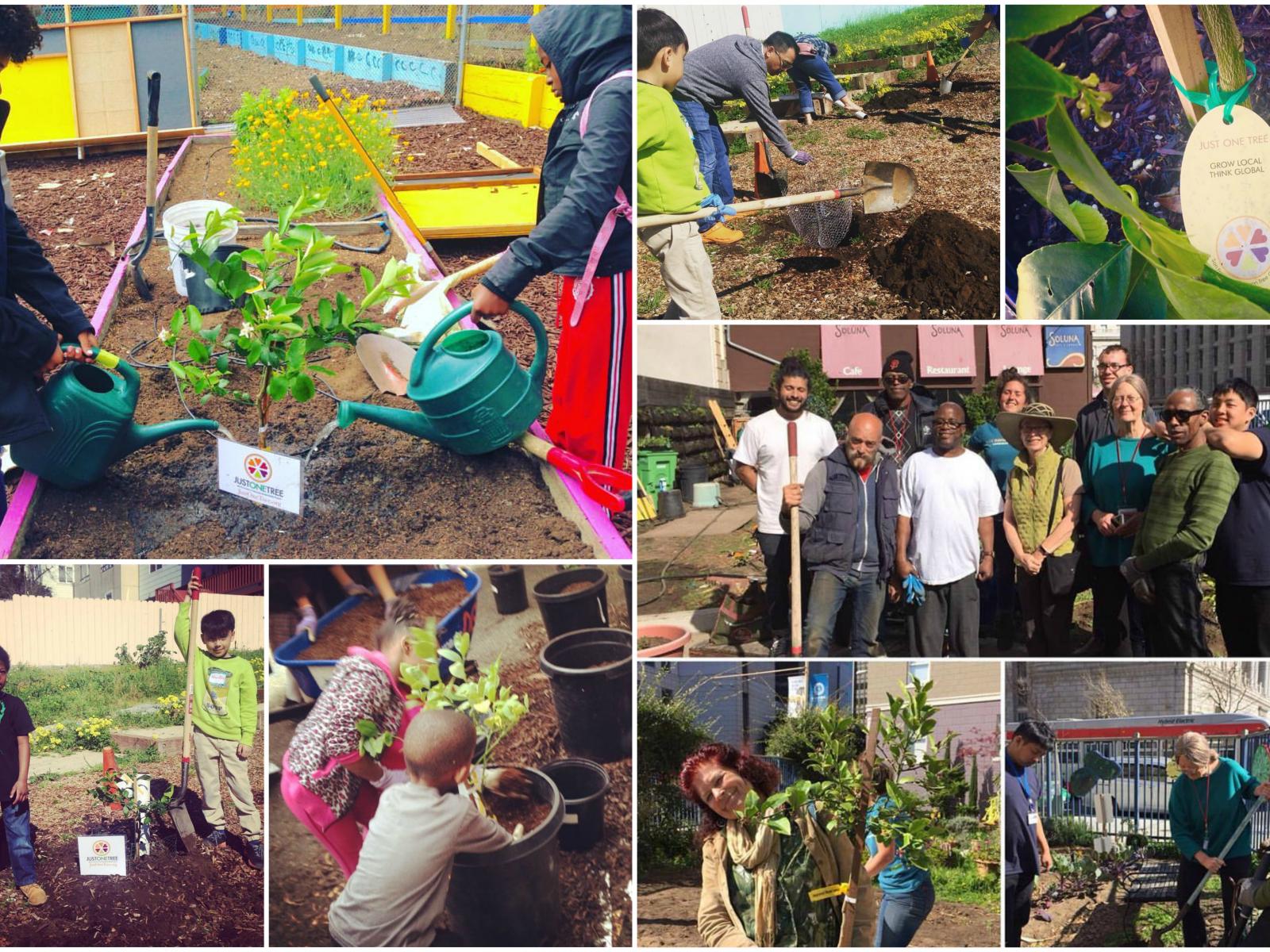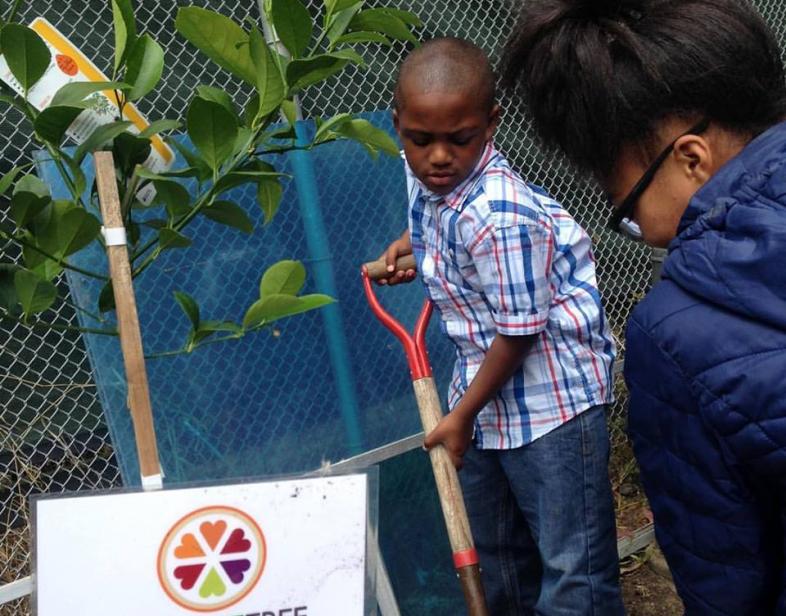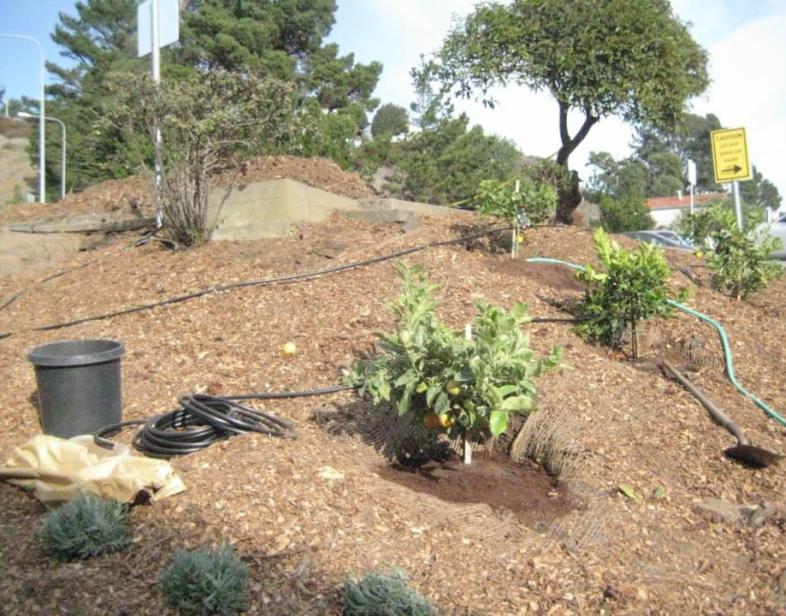An Overview Of Our Solution
Just One Tree is a grassroots nonprofit campaign whose goal is to help San Francisco become self-reliant in a food crop and to serve as an example to cities of all sizes across the country. By providing, planting, and tracking our emblem crop, Meyer lemon trees, we hope to reach a city total of 12,000—the amount of trees estimated to meet SF’s yearly consumption of lemons. We encourage home garden production as well as establish ‘orchards’ in public spaces--in community gardens, schoolyards, and institutional environments with open land. City residents register their own trees. Awareness of the initiative is promoted privately in a new partnership with SF Friends of the Urban Forest. We are seeking resources to more widely promote the campaign, plant more trees, and educate the public on the importance of and opportunities for greater food self-reliance.
- Population Impacted: 880,000 (SF population)
- Continent: North America
Context Analysis
The Department of Public Works estimates SF has 400 acres of open space. Many public institutions have spaces that are perfect for mini-orchards or groves. Also, according to the SF Chronicle in 2017, 1 in 4 SF families struggle with hunger and food insecurity. Just One Tree promotes the benefits of edible gardening and environmental sustainability through self-reliant food production. Bringing awareness about tree crop advantages and growing fruit trees throughout SF, we use the Meyer lemon tree as our emblem crop because a regional study indicated we are deficient in growing citrus in the Bay Area, lemons can even grow in pots (allowing all residents to participate in the campaign), and they have myriad uses. JOT strives to show that residents of a city can provide for themselves, combat the costs and limitations of imported produce (reducing our carbon footprint), and choose healthy options--to address the concerns of hunger and climate change.
Describe the technical solution you wanted the target audience to adopt
1) Meet the goal of 12,000 lemon trees, the estimated need using USDA consumption figures for a city of 850,000, by capturing the location of existing or newly-planted trees in home gardens or mini-orchards or groves. Mapping allows JOT and other nonprofits or city agencies to determine deficiencies of production in specific neighborhoods.
2) Provide a comprehensive website and easy-to-use registration form online to allow home garden planters or volunteer ‘lemon spotters’ to register their trees and also learn about their care.
3) Maximize use of public land for food production by planting community groves in available spaces where stewardship arrangements can be established.
4) Develop an App that allows for easier lemon-tree spotting by volunteers.
Type of intervention
Describe your behavioral intervention
People tend to think that food production in dense cities cannot make much of an impact on either hunger or climate change, yet food-related transportation is one of the most significant causes of climate change. Even the regional Food Bank does not list food production as one of the solutions to food insecurity in our area. Just One Tree is trying to motivate San Francisco residents to “Plant Local, Think Global” and to imagine a city where locally grown fruit is abundantly available, where anyone hungry can go to the Neighborhood Food Hub to get a healthy meal that includes produce and fruit from the neighborhood as well as the region. We want to help young people receive training in and get excited about urban agriculture. Through plantings of lemon groves, we work to convert public land to edible gardens and farms that contribute to the city’s food budget and impact climate change. Through education at public events, use of social media and our website, and distribution of printed materials, we have engaged the local community to register their own trees to meet our goal: The Just One Tree map of registered lemon trees in San Francisco can be viewed here: https://justonetree.org/tree-map/
As needed, please explain the type of intervention in more detail
Just One Tree calls on San Francisco residents to be aware of food scarcity in the urban environment and the effects of climate change to motivate more local edible tree planting. Through tabling at farmers markets, planting events and educational materials (digital and printed), we strive to appeal to people's emotions regarding food justice, social justice and environmental stewardship. By conveying the benefits of growing, buying and promoting "local", we promote an alternative choice to typical grocery store imports.
Describe your implementation
We continue to register existing lemon trees in San Francisco, and we are also celebrating the planting of our 12th JOT Community Lemon Grove. Groves range from 50 trees in the low-income Tenderloin district of San Francisco (some of these still to be planted) to 3 trees at Alemany Farm. Every JOT Grove has a sponsor and a steward who commits to watering and care. Most plantings are in public spaces but some are on rooftops. The oldest grove (27 trees at the Juvenile Justice Center planted in 2014/2015) is producing pounds of lemons that are used on site. Our objective for public land is to continue to plant as many groves as we can in the thousands of acres of open space that are underutilized in San Francisco.
Just One Tree also:
1.) Purchases (through sponsorships) Meyer lemon trees, organic fertilizer, pots and planting materials for public plantings.
2) Organizes monthly planting days at San Francisco school and community gardens through continued partnerships with Climate Action Now, Urban Sprouts, and Friends of the Urban Forest.
3) Tables at monthly planting events and provides educational material about urban agriculture, sustainability, Just One Tree's mission, and Meyer lemon tree care. We register lemon tree owners to increase planting number to help reach 12k goal.
4) Follows up to ensure stewardship of trees planted and gleaning of fruit produced.
5) Promotes Just One Tree mission and call for lemon tree registrations via press coverage and ads in local environment- and food-related publications.
We gauge success by the number of trees registered. Our main obstacle is lack of sufficient resources to spread the word about the project. We are a mostly all-volunteer operation with one part-time consultant. We would benefit from funds that would allow a major media blitz to raise the project visibility because enthusiasm among those who do know about the project is very high. We would also love to have an App developed for this purpose.
External connections
Just One Tree sponsors include Lennar, PG&E, Segment, Inc. the Elkes Foundation, and Home Advisor.
Just One Tree partners with: City of San Francisco, SPUR, Friends of the Urban Forest, SF Parks Alliance, Education Outside, Urban Sprouts, Master Gardeners, The Juvenile Justice Center, Urban Agriculture Alliance, UC Hastings Demonstration Garden, University of California Cooperative Extension
We also have private donors who contribute to support this campaign.
Dr. Wade, founder of Urban Resource Systems and the Just One Tree Campaign, was a member of SPUR’s Urban Agriculture Committee for 5 years. She continues to promote the campaign and the concept of increasing urban self reliance with City officials and elected.
Who adopted the desired behaviors and to what degree?
Both public agencies, private citizens, and Community gardens have all eagerly participated in the Just One Tree Campaign. Just One Tree has planted trees at 20 different garden sites throughout San Francisco and has also disseminated Meyer lemon trees to residents through our partnership with Friends of the Urban Forest. We have nearly 2,000 trees registered in our database; this represents 16% of our goal of 12,000. We are not certain of how many private home owners have planted trees as a result of the campaign. Our campaign plan envisions two phases of the project: 1) registering existing trees (est. 4000) 2) a major planting campaign (approx. 8000). These phases overlap in the public grove component that we launched from the beginning.
How did you impact natural resource use and greenhouse gas emissions?
According to Google, as a tree matures, it can consume 48 pounds of carbon dioxide per year as it turns that CO2 into parts of itself. It also releases enough oxygen to supply your needs for two years. Therefore, 2000 trees (most are mature) would consume 96,000 pounds of CO2 and supply enough oxygen for 2000 city residents for 2 years.
What were some of the resulting co-benefits?
Social: community tree planting brings people together and helps to create lasting relationships
Water: fruit trees require about 10 gallons of water a week to establish; average Californian uses 85 gallons a day; can be watered with grey water.
Nutrition: fruit provides critical vitamins and minerals, and fiber. Lemons especially provide Vitamin C and folate
Economic Development: Meyer Lemons cost more than a $1.00 each for much of the year; collection and sale/barter can be an important income supplement. Preparation of lemon products can now occur in San Francisco in neighborhood kitchen incubators.
Conservation: backyard trees and public groves provide vital habitat corridors for birds
Sustainable development: 12,000 lemon trees would meet self-sufficiency goal for SF.
Sustainability
Just One Tree relies primarily on donations and some grant funding. We have only one part-time program consultant so our overhead is very low and the cost of trees and materials is relatively minor. Once tree planting has taken place, the stewardship component is self-reliant.
Return on investment
Just One Tree began in 2013. We have spent approximately $100,000 on the campaign, or approximately $50/tree. This includes early development of the website, tree registry, advertisement/print media mostly at the beginning.
How could we successfully replicate this solution elsewhere?
This campaign has not been done elsewhere and would be easy to implement once a suitable food crop is identified to meet convenient growth within a city’s climate/conditions. Partnering with community gardens, schools, housing development organizations and local environmental groups is key to coordinating planting sites and outreach to residents. City support, if available, would be very helpful in promoting the effort. Funding needs are limited but for faster achievement of the goal, sponsors for outreach are needed and very helpful.






